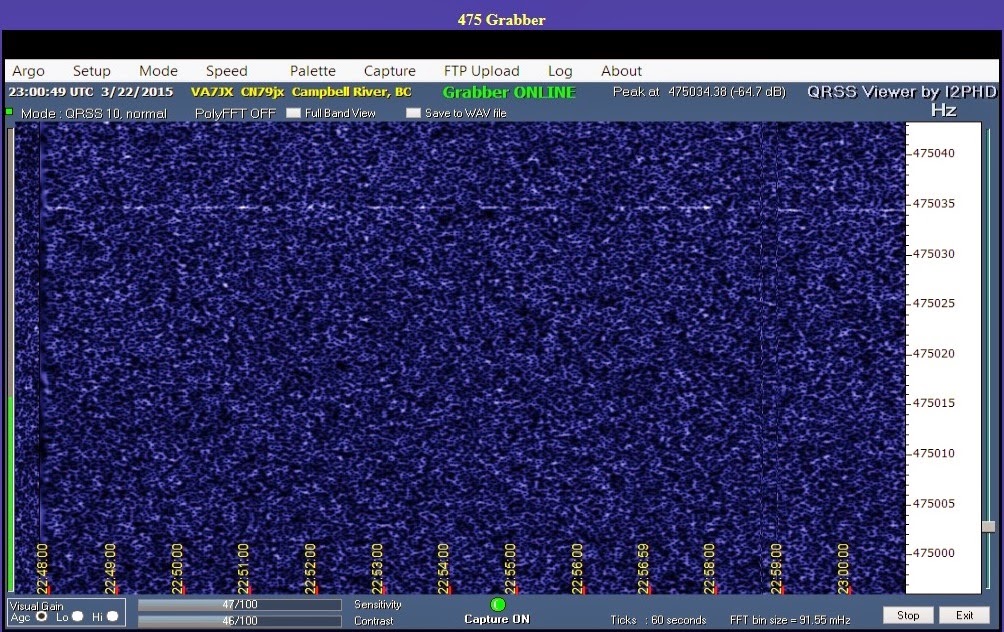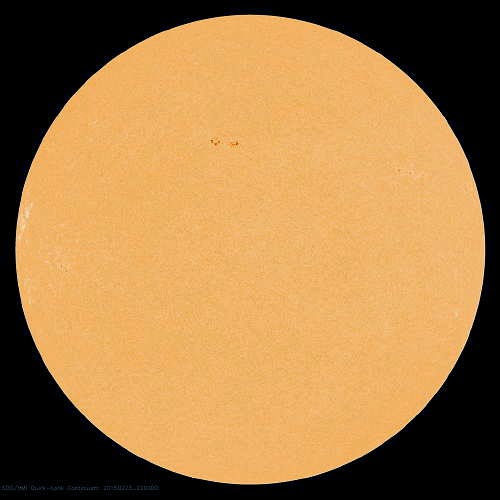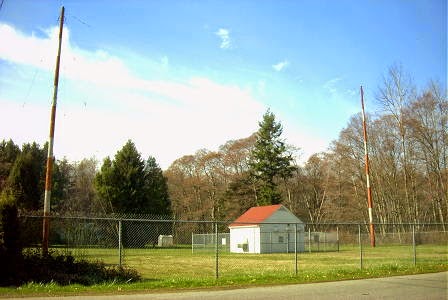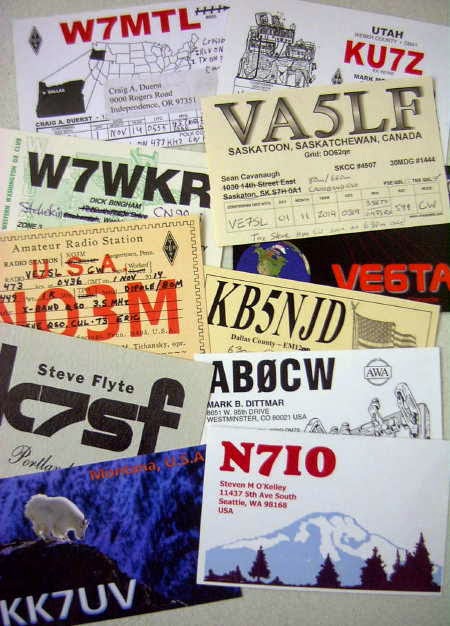Posts Tagged ‘630m’
 A 630m QRSS Test
A 630m QRSS Test
Mark was transmitting on 630m at a power of just 144mW output, while Jack was receiving on his normal 630m inverted 'L'. Mark tried various QRSS speeds ranging from QRSS3 (3 second 'dits') to QRSS60 (60 second 'dits'). One can clearly see the difference between the three speeds.
Going from the relatively slow CW rate of 6 WPM to just QRSS3 alone, produces a healthy 12db increase in signal level. Going from there to QRSS10 produces another 5db, while going all the way to QRSS60 produces a whopping 24.8db over 6 WPM CW! The trade off, of course, being the amount of time it takes to send the needed information.
In practical terms, contacts can be made relatively quickly at both QRSS3 and QRSS10. After that it becomes a bit of a chore as conditions need to be very stable for long periods of time ... as well, you'll need several hours to complete a two-way exchange.
 | |
| courtesy: https://www.google.com/earth/ |
| VA7MM - QRSS3 |
 |
| VA7MM - QRSS10 |
 |
| VA7MM - QRSS60 |
 |
| courtesy: http://www.heywhatsthat.com/profiler.html |
I should add that Mark's transmitting antenna is very minimal at the moment, consisting of an 80m dipole fed as a vertical 'T', tuned but not impedance-matched and ... no ground radials. Pretty remarkable actually.
 Low Noise Vertical Follow Up
Low Noise Vertical Follow Up
 The recent posting by BCB / NDB DXer, Steve Ratzlaff (AA7U in OR), describing the poor performance of his initial LNV, prompted another round of valuable discourse on the Yahoo NDBlist Group. Steve indicated that his new 40' LNV was virtually deaf compared to his loop and active whip. ... until he rewound the transformers.
The recent posting by BCB / NDB DXer, Steve Ratzlaff (AA7U in OR), describing the poor performance of his initial LNV, prompted another round of valuable discourse on the Yahoo NDBlist Group. Steve indicated that his new 40' LNV was virtually deaf compared to his loop and active whip. ... until he rewound the transformers."I've fixed the very low sensitivity of my 40 foot LNV. The transformer
needed more turns for my particular setup--that made all the difference
in the world. I'm also using coax cable, not twin lead--that apparently
makes a big difference in the proper transformer turns ratio too. But
the LNV with preamp is now about the same sensitivity as the active whip.
My transformer primary uses 110 turns, to give good reactance at
the low end of the NDB band. I started with 21 turns on the secondary,
tuned to my local beacon LGD on 296 and looked at the signal level,
removing two turns each time until I got to 8 turns. A broad peak was
with 16 turns which is what I used for the final secondary turns. That's
a turns ratio of 110/16 = 6.875.
Total coax run from the mast to the middle of the home is about
135 feet where it enters the home.
I did some ground rod checks for signal level too. I have 3 ground rods
installed at the LNV--6 foot, 4 foot and a short 2 foot. I started out
with all three connected and took a reference signal reading, then just
the 6 foot; then just the 4 foot and then just the 2 foot. Signal level
dropped several tenths of a decibel for the 2 foot rod and was the same
for the 4 and 6 foot rods by themselves and for all 3 rods connected. So
my particular setup likes something a little longer than 2 feet for the
ground rod. I'll leave all three rods connected for now since they're
already in place.
The LNV being in a different location is now quieter on some lower end
signals where the active whip is noisy due to the whip being closer to
AC power--a nice thing. The low end 195-205 kHz especially are often
unusable due to noise; the LNV is much quieter for those, apparently due
to it being 100 feet farther from the AC power at the home.
So, the bottom line is my LNV is now working like it should, I believe.
I'll continue to use it and do more comparison checks since I can switch
my antennas instantly."
From Roelof, PAØRDT:
" ... I believe the term low noise vertical is a bit misleading. These verticals are only suffering less from local noise compared to loop antennas when
located close to the house.
The reason is that the vertical is receiving the electric field and
the electric field of local noise sources located in the house fall
off very quickly outside the house, especially at LF and MW.
A loop antenna does receive the magnetic field of local noise
sources and this field does not fall off close to the house.
I can demonstrate this effect here any time with my modified ALA1530
and mini-whip antenna.
"Matching" this type of vertical to the 50 ohm input of a receiver
is interesting. Connecting it directly to the receiver input, will
load the antenna too much and the voltage across the antenna
terminals will collapse.
This problem can be solved by using a high input buffer amplifier as
used in active whips or by a voltage step down transformer.
Due to imperfections in the step down transformer, e.g.
inter-winding capacitance and insufficient inductance of the
receiver tap / secondary winding, signal output will be way down
compared to an active whip of the same length, using a high input
impedance buffer amplifier.
You can use a tuned vertical to overcome this, however doing so the
broad band nature of the antenna is lost.
Living close to strong broadcast stations, which prevent the use of
active antennas, this particular type of E-probe is an excellent
alternative."
And from Anthony Casorso in CO:
"Motivated by your posts, I build a new transformer using an FT140J with 100 turns on the antenna side and a 10 tap secondary with a rotary switch to select the tap. The taps were from 8 turns to 26 turns in 2 turn increments.
And finally Don, in California:
"Well, with 50% more turns (12T) on the secondary winding there is alot
more output. Around 520 kHz I was running the Perseus volume almost all
the way up - now it is about half.
I'm using ~33m 75 oHm coax from the LNV to the Perseus - no RF amp -
plenty of signal. My LNV output is about 15 - 20 dbm less according to
the Perseus than the PA0RDT and Wellbrook ALA-100 but I don't seem to be
missing any signals because of the lower "S" reading. I'm amazed that it
seems to work well so I'm trying not get tangled up in numbers. I don't
think it is possible to have a perfect match with hard wired components
and changing frequencies.
The secondary seems to need at least 8T with a 80T primary in my little
LNV experiment and 12T is better. When I get the 28ga wire I will wind a
primary of 110T to match Steve R's LNV coil with a secondary of 12T to
start with."
Of interest to note is the use by both Steve and Roelof of the RPA-1 preamp.
 |
| courtesy: www.dxengineering.com/ |
has about +18 dB gain. The stock preamp rolls off gain below about 300
kHz; mine is flat down to VLF. (The input transformer needs more turns,
that's all that's needed.) "
 Over 1000km on 472kHz TX with earth-electrodes
Over 1000km on 472kHz TX with earth-electrodes
Last night LA4ANA (1047km) copied my 5mW ERP from the earth-electrode “antenna” on 472kHz WSPR. This is my best DX yet on the non-antenna, nearly 300km further than my best previous TX record. I was also spotted by DL4YHF (556km) for the first time on the earth-electrode “antenna”. My PC decided to crash some time after midnight last night, so I missed any DX overnight. These spots were during the evening period.
In the last 2 weeks alone I have been spotted by 28 different stations when I’ve been using 5mW ERP from the earth-electrode “antenna” on 472kHz WSPR. Let no-one say 472kHz is out because they cannot fit an antenna! If my signal can span over 1000km with WSPR then you can surely do better. I make no claims for the earth-electrode “antenna” but if you are unable to erect a proper antenna give it a go.
I have still to try it at this QTH on 136kHz but at my old QTH I managed to be spotted at 250km with very low ERP.
 CLE191 Results
CLE191 Results
 |
| http://helios.gsfc.nasa.gov/chole.html |
With my Perseus SDR taking 2-minute spectrum captures once per hour, from dusk through dawn, the short propagation lifts become quickly evident ... the majority of my loggings were made during these short windows of propagation:
21 04:00 260 ZXS Prince George, BC, CAN
21 02:00 260 YSQ Atlin, BC, CAN
22 07:00 260 AVZ Terrell, TX, USA
21 02:00 260 AP Sedalia, CO, USA
21 13:00 261 D6 Fairmont Hot Springs Apt, BC, CAN
22 09:00 263 ZQT Thunder Bay, ON, CAN
21 09:00 263 YGK Kingston, ON, CAN
21 09:00 263 YBB Kugaaruk, NU, CAN
21 13:00 263 JDN Jordan, MT, USA
21 08:00 263 3Z Russell Apt, MB, CAN
21 08:00 264 ZPB Sachigo Lake, ON, CAN
21 08:00 266 XD Edmonton, AB, CAN
21 02:00 266 VR Vancouver, BC, CAN
21 08:00 266 SL Turner, OR, USA
21 08:00 266 SAA Saratoga, WY, USA
21 08:00 266 ICK Annette Island, ALS
21 08:00 266 BZ Bozeman, MT, USA
21 13:00 268 ZWL Wollaston Lake, SK, CAN
21 08:00 269 ZW Teslin, YT, CAN
21 04:00 269 YK Castlegar, BC, CAN
21 08:00 269 UDE Delta Beach, MB, CAN
22 09:00 269 SWT Seward, NE, USA
22 09:00 269 PK Park Rapids, MN, USA
22 09:00 269 ISB Sibley Municipal Apt, IA, USA
21 08:00 269 CII Choteau Apt, MT, USA
23 08:00 510 OF Madison, NE, USA
21 10:00 512 HMY Lexington, OK, USA
21 10:00 515 SAK Kalispell, MT, USA
23 08:00 515 PN Ponca City, OK, USA
23 08:00 515 OS Columbus, OH, USA
21 10:00 515 CL Cresent Beach, WA, USA
22 09:00 516 YWA Petawawa, ON, CAN
23 08:00 521 TO Topeka, KS, USA
22 08:00 521 ORC Orange City, IA, USA
21 10:00 521 INE Missoula, MT, USA
23 08:00 524 HRD Hawthorne, TX, USA
21 09:00 525 ICW Nenana, ALS
21 09:00 529 SQM Big Level Isl, ALS
21 08:00 1725 WH2XDE/3 MA
21 08:00 472.4 VE7CNF BC
21 06:00 474 VE7BDQ BC
21 08:00 475.5 WG2XSV WA
In just a few years the Sun should be very very quiet for several winters, offering some superb LF listening once again.
 CLE191 Addendum
CLE191 Addendum
 |
| WC-332KHz - White Rock, BC |
From Neil (WØYSE):
WG2XSV (experimental callsign) will be running a CW beacon on 475.475 kHz for this event.
(In fact it is already running as of 0001 UTC 20 Feb).
Power is ~1 watt ERP (+/- 1 dB) from SW Washington State.
Reports appreciated to wØyse [at] ARRL[dot] net
I'm sure Neil would be delighted to receive any heard reports from his weekend CW beacon. Remember that this CLE also covers the 630m band and CW beacons that may be operational there.
If you know of any other 630m CW beacons that will be activated, please let me know and I will post the information here.
Also, CLE reports may be mailed to either myself, the CLE Yahoo list or to Brain Keyte, CLE organizer. Brian's address is: ndbcle@gmail.com
Reports should include your exact location (Lat/Long preferred or exact Gridsquare), your full name and e-mail address in case Brian needs to send an enquiry regarding your log.
The finer-details of CLE191 may be found in Wednesday's blog.
Lets hope conditions stay nice and quiet as they appear to be doing.
 Hunting For NDB’s In CLE191
Hunting For NDB’s In CLE191
 |
| One CLE Target - 'VR' 266KHz / Vancouver Int'l Approach |
How time flies. For you low-frequency buffs, another challenge awaits. From CLE coordinator Brian Keyte (G3SIA) comes the following reminder:
"Our February Co-ordinated Listening Event will soon be here.
We'll be hunting for normal beacons in two contrasting frequency ranges.
One range also gives the possibility of hearing several amateur beacons.
As always, first-time CLE logs will be extra welcome.
Days: Friday 20 February - Monday 23 February
Times: Start and end at midday, your local time
Frequencies: 260.0 - 269.9 kHz
plus: 440.0 - 1740.0 kHz
Many of us should be able to hear beacons in both ranges, though Europe
only has a handful in the '260s'. From 440 onwards, Eastern Europe and
North Africa have several beacons and some regular UNIDs and some NDBs
can be found among Europe's Medium Wave Broadcast Stations.
Many of us are within range of some of the amateur beacons on frequencies around 470 kHz and 500 kHz - we'll be listening for ANYTHING OPERATING IN BEACON MODE, preferably with normal speed Morse.
(We ask operators who sometimes use QRSS, PSK, WSPR, etc., which need
software to receive them, to PLEASE CHOOSE THE SIMPLER MODE during
the CLE so that we shall all be able to receive and report them).
Send your CLE log to the List, preferably as a plain text email
and not in an attachment, with CLE191 at the start of its title.
Please show on EVERY LINE of your log:
# The full Date (or Day no.) and UTC (the day changes at 00:00 UTC).
# kHz (the beacon's nominal published frequency, if you know it)
# The Call Ident.
Other optional details, Location, Distance, etc., go LATER in the same
line (or in footnotes). Any extra details about UNIDs, especially strong
ones that may be near to you (maybe their approximate direction, etc.)
will help us to discover more about them. As always, please make your
log useful to old and new members alike by including your own location
and brief details of the equipment and aerial(s) you were using.
I will send an 'Any More Logs?' email at about 18:00 UTC on Tuesday
evening. From it you can check that your log has been found OK.
Do make sure that your log has arrived at the very latest by 09:00 UTC
on Wednesday 25 February.
I hope to finish making the combined results on that day."
These listening events serve several purposes. They:
- determine, worldwide, which beacons are actually in service and on-the-air so the online database can be kept up-to-date
- determine, worldwide, which beacons are out-of-service or have gone silent since the last CLE covering this range
- will indicate the state of propagation conditions at the various participant locations
- will give you an indication of how well your LF/MF receiving system is working
- give participants a fun yet challenging activity to keep their listening skills honed
Final details can be found at the NDB List website, and worldwide results, for every participant, will be posted there a few days after the event. If you are a member of the ndblist Group, results will also be e-mailed and posted there.
The very active Yahoo ndblist Group is a great place to learn more about the 'Art of NDB DXing' or to meet other listeners in your region. There is a lot of good information available there and new members are always very welcome.
If you are contemplating getting started on 630m, listening for NDBs is an excellent way to test out your receive capabilities as there are several NDBs located near this part of the spectrum.
You need not be an ndblist member to participate in the CLEs and all reports, no matter how small, are of much value to the organizers. 'First-time' logs are always VERY welcome!
Reports may be sent to the ndblist or e-mailed to either myself or CLE co- ordinator, Brian Keyte (G3SIA), whose address appears above.
Please...do give the CLE a try....then let us know what NDB's can be heard from your location! Your report can then be added to the worldwide database to help keep it up-to-date.
 630m Crossband Tonight!
630m Crossband Tonight!
Just a reminder about the 630m crossband activity night this evening. There have been two updates to the plan. VE7SL will start one hour later than originally planned and John, VE7BDQ, will be listening on both 160m and 80m QSX frequencies for callers.
The frequencies will be:
- VE7SL TX 473.00KHz QSX (listening) 1808KHz (160m) and 3535KHz (80m)
- VE7BDQ TX 474.00KHz QSX (listening) 1813KHz (160m) and 3532KHz (80m)
The last time this was done, transcontinental contacts were completed ... hopefully conditions will continue to co-operate and propagation will be good tonight.














